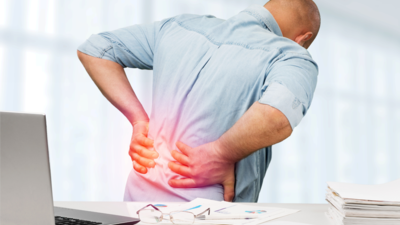- News
- lifestyle
- health-fitness
- health-news
- 5 simple and easy home remedies to get rid of lower back pain
Trending
5 simple and easy home remedies to get rid of lower back pain
Lower back pain can be a debilitating condition, but these simple and easy home remedies can offer significant relief. Consistent and mindful application of these remedies can lead to a pain-free and healthier back.

Lower back pain is a common issue that affects many people, often disturbing our daily activities and reducing our quality of life. While severe cases may require medical attention, many instances of lower back pain can be managed with simple home remedies. These remedies are easy to do and cost-effective. Here are 5 effective home remedies to help reduce lower back pain.

Apply cold and heat therapy
Cold therapy: Applying ice packs to the affected area can significantly reduce inflammation and numb the sharp pain associated with lower back issues. Cold therapy is particularly effective within the first 48 hours after an injury. A study published in the Journal of Clinical Nursing found that cold therapy can reduce pain and improve mobility in patients with acute lower back pain. Wrap an ice pack in a cloth and apply it to the sore area for 15-20 minutes several times a day.

Heat therapy: After the initial 48 hours, heat therapy can be beneficial. Heat increases blood flow, which helps relax tight muscles and alleviate pain. A study in the US National library of medicines indicated that continuous low-level heat therapy could provide significant relief from acute lower back pain. Use a heating pad or take warm baths to relax the muscles and improve circulation to the affected area.
Gentle stretching and exercise
Staying active and engaging in gentle stretching exercises can help strengthen the muscles around your lower back, improving flexibility and reducing pain. Here are a few simple stretches:
- Lie on your back, bend one knee, and bring it towards your chest. Hold for 15-30 seconds, then switch legs.
- Get on your hands and knees, arch your back (like a cat), then slowly lower it and lift your head and tailbone (like a cow). Repeat several times.
- Sit on your heels, stretch your arms forward, and lower your head to the ground. Hold for 30 seconds.
Exercises that help recover from hunch back
Maintain a good posture
Improper posture and poor ergonomics can contribute significantly to lower back pain. Maintaining good posture and ensuring your work environment is ergonomically friendly can prevent and alleviate pain. A study from the Journal of Physical Therapy Science highlights that proper posture can reduce strain on the back muscles and spine, leading to less pain and discomfort.
- Standing: Keep your shoulders back, and distribute your weight evenly on both feet.
- Sitting: Use a chair with good lumbar support, keep your feet flat on the ground, and avoid slouching.
- Lifting: Bend your knees and keep your back straight when lifting objects. Avoid twisting your torso.
Try herbal remedies and essential oils
Certain herbs and essential oils have anti-inflammatory and analgesic properties that can help reduce lower back pain. For instance, a study published in the Journal of Alternative and Complementary Medicine found that applying lavender essential oil combined with acupressure significantly reduced pain in patients with lower back pain. Here are some popular options:
- Turmeric: Known for its anti-inflammatory properties, turmeric can be consumed as a supplement or added to food.
- Ginger: Consuming ginger tea or using ginger essential oil can help reduce pain and inflammation.
- Peppermint oil: Applying diluted peppermint oil to the affected area can provide a cooling effect and relieve pain.
Relaxing techniques
Stress and tension can contribute to lower back pain, making relaxation techniques an important part of pain management. Meditation and relaxation exercises, such as meditation, deep breathing, and progressive muscle relaxation, can help reduce stress and alleviate pain.
- Meditation: Spend a few minutes each day practising mindfulness meditation to help manage stress and focus on breathing.
- Deep breathing: Deep breathing exercises can help relax tense muscles and reduce pain. Inhale deeply, hold for a few seconds, then exhale slowly.
- Progressive muscle relaxation: This technique involves tensing and then slowly releasing each muscle group, starting from the toes and working up to the head.
End of Article
FOLLOW US ON SOCIAL MEDIA










